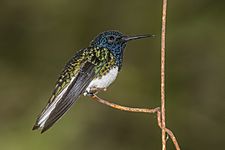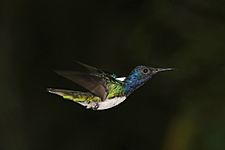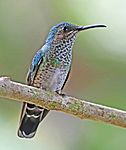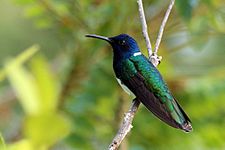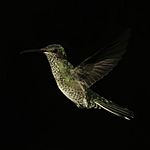White-necked jacobin facts for kids
Quick facts for kids White-necked jacobin |
|
|---|---|
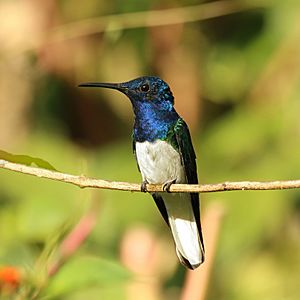 |
|
| Male F. m. mellivora, Trinidad | |
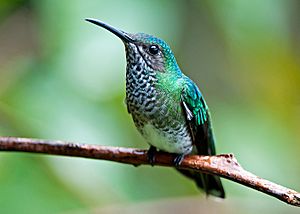 |
|
| Female, Costa Rica | |
| Conservation status | |
| Scientific classification | |
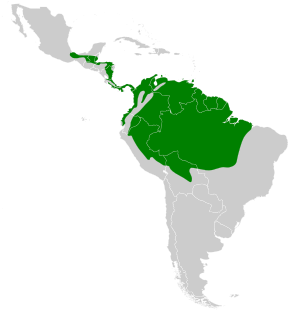 |
|
| Synonyms | |
|
Trochilus mellivorus Linnaeus, 1758 |
The white-necked jacobin (Florisuga mellivora) is a beautiful, medium-sized hummingbird. You can find these birds from Mexico all the way south through Central America and northern South America. Their range extends into countries like Brazil, Peru, and Bolivia. They also live on the islands of Trinidad & Tobago.
People sometimes call them the great jacobin or the collared hummingbird.
Contents
What is a White-necked Jacobin?
The white-necked jacobin is a type of hummingbird. It was first described by a Swedish scientist named Carl Linnaeus in 1758. He gave it the scientific name Trochilus mellivorus. The word mellivorus means "honey-eating" in Latin, which makes sense for a hummingbird! Later, scientists placed it in a different group, or genus, called Florisuga.
Types of White-necked Jacobins
There are two main types, or subspecies, of the white-necked jacobin:
- F. m. mellivora: This is the most common type.
- F. m. flabellifera: This type is found only on the island of Tobago.
How to Spot a White-necked Jacobin
These hummingbirds are about 11 to 12 centimeters (4.3 to 4.7 inches) long. Males are easy to spot because they look very different from females.
Male Jacobins
Male white-necked jacobins have a striking look. Their head and chest are a dark, shiny blue. Their belly and tail are bright white. The tips of their tail feathers are black. They also have a white band on their neck, which separates their blue head from their bright green back.
Female Jacobins
Female white-necked jacobins can look quite different from each other. Most females have green upper parts. Their throat and chest are blue-green with white marks that look like scales. Their belly is white, and their tail is mostly green with a blue end. Young males can sometimes look like females, but they usually have more white in their tail.
Where Do White-necked Jacobins Live?
The most common type, F. m. mellivora, lives in many places. You can find them from southern Mexico down through Central America, including Belize, Guatemala, Honduras, Nicaragua, Costa Rica, and Panama. In South America, they live in Colombia, Ecuador, eastern Peru, northern Bolivia, Venezuela, the Guianas, and northwestern Brazil. They also live on the island of Trinidad.
The other type, F. m. flabellifera, only lives on the island of Tobago. Sometimes, white-necked jacobins have been seen in Argentina and on the islands of Aruba and Curaçao, but these are rare visits.
Their Home Environment
White-necked jacobins like to live in humid forests. They are often seen high up in the trees, especially at the edges of forests or in clearings. They also live in places like coffee and cocoa farms. They usually live from sea level up to about 900 meters (3,000 feet) high. Sometimes, they can be found even higher, up to 1,500 meters (4,900 feet).
White-necked Jacobin Behavior
These hummingbirds are always on the move!
Movement and Migration
Scientists are still learning about how white-necked jacobins move around. It seems they travel seasonally, following where flowers are blooming. This helps them find enough food.
What Do They Eat?
White-necked jacobins mostly eat nectar from flowers. They get nectar from tall trees, plants that grow on other plants (called epiphytes), shrubs, and Heliconia plants. Several jacobins might feed in the same tree. They can be a bit aggressive towards each other when feeding, but they usually don't try to claim a territory. Both male and female jacobins also catch small insects. They do this by hovering in the air, darting quickly, or flying out from a branch to catch bugs.
Reproduction and Life Cycle
White-necked jacobins usually breed during the dry season or early wet season. The exact time depends on where they live. The female builds a small, cup-shaped nest using plant fuzz and spiderwebs. She places it on top of a leaf, often under another leaf that acts like a roof. Nests are usually about 1 to 3 meters (3 to 10 feet) off the ground, sometimes near a stream.
During breeding season, males will show off and chase each other in the treetops. If a predator comes near the nest, the female will flutter her wings to try and distract it.
Sounds They Make
White-necked jacobins are not very noisy birds. Their song is a long series of high-pitched notes, repeated slowly, like "tseee....tseee....tseee....tseee....". They also make short "tsik" sounds, a longer "sweet" sound, and a descending "swee-swee-swee-swee" when they are fighting with other birds.
Conservation Status
The IUCN (International Union for Conservation of Nature) says that the white-necked jacobin is a species of "Least Concern." This means they are not currently in danger of disappearing. They live across a very large area. While we don't know exactly how many there are, they are common in most places they live. They also seem to do well in areas changed by humans, like tree plantations, and they live in many protected natural areas.
Gallery
-
Male F. m. mellivora, Panama
-
Male F. m. mellivora, Panama
-
Female F. m. mellivora, Milpe, Ecuador
-
Male F. m. flabellifera, Tobago
-
Female F. m. flabellifera, Tobago
-
male F. m. mellivora, Costa Rica
See also
 In Spanish: Jacobino cuello blanco para niños
In Spanish: Jacobino cuello blanco para niños



